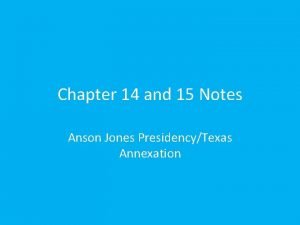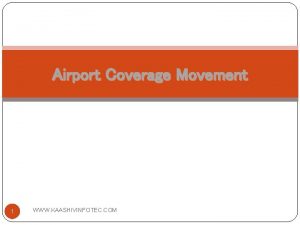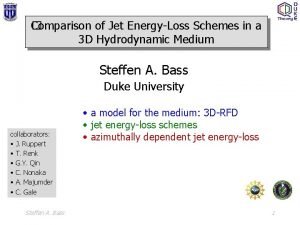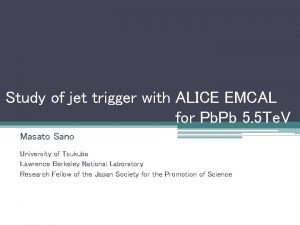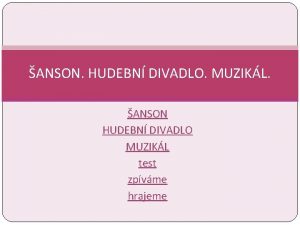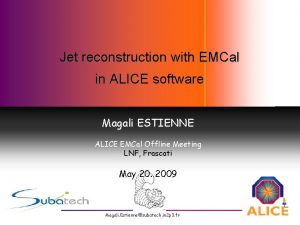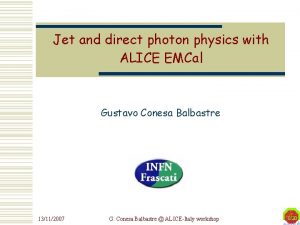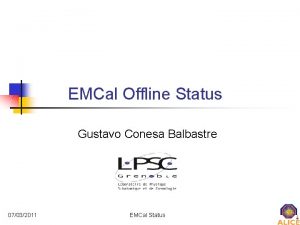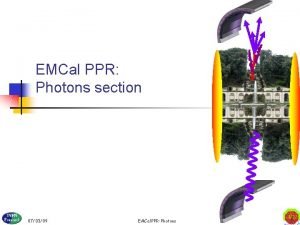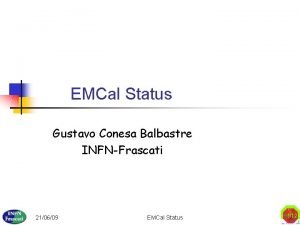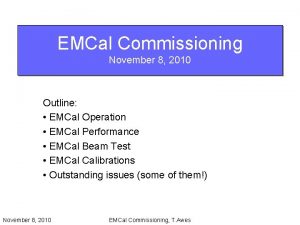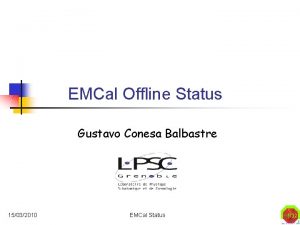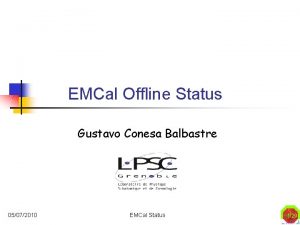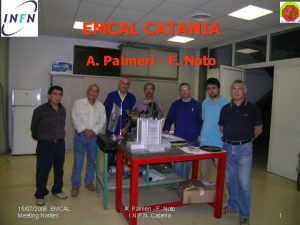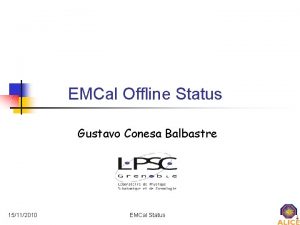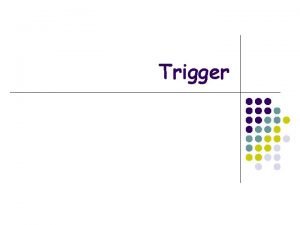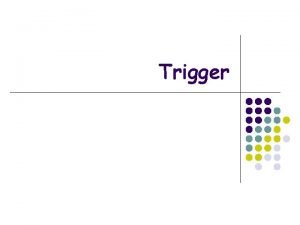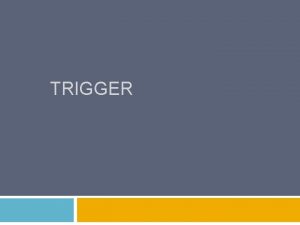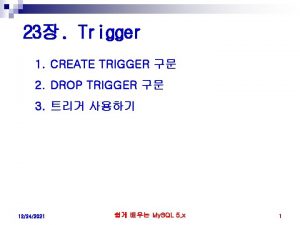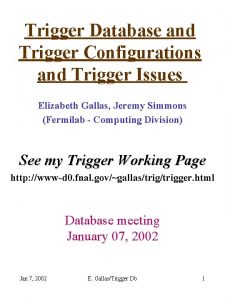EMCal Jet Trigger Analysis for ALICE Christopher Anson






















- Slides: 22

EMCal Jet Trigger Analysis for ALICE* Christopher Anson Creighton University *Supported by the U. S. DOE Office of Science Christopher Anson http: //pdsfweb 01. nersc. gov/~canson/Hijing. HTMLStuff. html

Introduction The goals of this study are to… • Investigate trigger properties starting with event simulations + simple assumptions about detector. • Compare conclusions with other results starting with advanced simulations of detector response. • Investigate the underlying physics and behavior of triggers. By using… • 2 million jet events with Ali. Pythia • 1000 background events with HIJING Pb+Pb Christopher Anson http: //pdsfweb 01. nersc. gov/~canson/Hijing. HTMLStuff. html 2

Outline I. Jet Triggers with Pythia Jets II. a) Leading 0 trigger III. b) Cone trigger IV. c) Patch trigger II. Patch Triggers with Pythia Jets and HIJING Background a) Jet vs. background energy in patches b) Centrality dependence III. Patch Triggers with Rate Requirement Introduced Christopher Anson http: //pdsfweb 01. nersc. gov/~canson/Hijing. HTMLStuff. html 3

Trigger Requirements • Reduce data rate into higher level trigger • Efficient jet selection at lowest possible energy • Use most efficient patch size Christopher Anson http: //pdsfweb 01. nersc. gov/~canson/Hijing. HTMLStuff. html 4

Rates at ALICE Interaction Rate ~ 4 k. Hz Into High Level Trigger ~100 Hz Data to tape rate ~ 100 Hz Need 100% efficiency above ~ 100 Ge. V inclusive jets 10 Hz @ 50 Ge. V And enhancement at 50 Ge. V few x 10 4/year for E T>150 Ge. V Must reduce data rate by 10 -50 times From Peter Jacobs Christopher Anson An EMC for ALICE http: //pdsfweb 01. nersc. gov/~canson/Hijing. HTMLStuff. html 5

Leading 0 Trigger Investigating efficiency for different cuts Cut Energy • 2 Ge. V cut • 4 Ge. V cut • 6 Ge. V cut Conclusions: • Increasing cut reduces efficiency for high energy jets. • Some higher energy jets have a low energy leading 0. Christopher Anson http: //pdsfweb 01. nersc. gov/~canson/Hijing. HTMLStuff. html 6

Cone Trigger with Different Cone Radii Cone is around Pythia jet axis 100% e+, e-, energy Cone Radius • R = 0. 05 • R = 0. 10 • R = 0. 20 • R = 0. 30 • R = 0. 40 Christopher Anson 25% hadron energy Conclusions: • Reduced efficiency for smaller cones • Sometimes jet energy is not centralized near Pythia defined jet axis http: //pdsfweb 01. nersc. gov/~canson/Hijing. HTMLStuff. html 7

Patch Trigger Slides Across the Detector In reality the smallest 2 x 2 Tower units are ~ 0. 028 x 0. 028 Smallest patches I use are 0. 05 x 0. 05 Larger patches are built from summing the smaller patches The patches looked at in my study are: 0. 05 x 0. 05 = 1 x 1 ~ 0. 05 0. 10 x 0. 10 = 2 x 2 0. 15 x 0. 15 = 3 x 3 x ~ 0. 15 x 0. 15 0. 20 x 0. 20 = 4 x 4 0. 25 x 0. 25 = 5 x 5 Christopher Anson http: //pdsfweb 01. nersc. gov/~canson/Hijing. HTMLStuff. html 8

Patch Trigger vs Cone Trigger 10 Ge. V cut x = 0. 15 x 0. 15 patch Cone has equal area Trigger Type • 0. 15 x 0. 15 Patch Trigger • Cone Trigger (Same Area) Conclusions: • Sometimes jet energy is not centralized near Pythia defined jet axis • Cone trigger has poor efficiency Christopher Anson http: //pdsfweb 01. nersc. gov/~canson/Hijing. HTMLStuff. html 9

Patch Size Dependance Energy is summed in dηxdφ patches Cuts produce 50% efficiency at fixed 72 Ge. V to investigate behavior of trigger Conclusion: • Patch trigger efficiency is independent of patch size Christopher Anson http: //pdsfweb 01. nersc. gov/~canson/Hijing. HTMLStuff. html 10

Patch Size Dependance Pythia + assumption of 25% hadron energy detected Agrees with full GEANT simulation Cuts produce 50% efficiency at 72 Ge. V to investigate behavior of trigger Conclusion: • Patch trigger efficiency is independent of patch size *Full GEANT simulation: Bill Mayes, Houston Christopher Anson http: //pdsfweb 01. nersc. gov/~canson/Hijing. HTMLStuff. html 11

Comparing Patch Trigger and Leading 0 Trigger 1 x 1 patch trigger doesn’t reduce to leading π0 trigger Type • 0. 05 x 0. 05 Patch Trigger • Leading π Trigger 0 Christopher Anson Turning off the energy deposited by hadrons… http: //pdsfweb 01. nersc. gov/~canson/Hijing. HTMLStuff. html 12

Comparing Patch Trigger and Leading 0 Trigger With energy in patch only due to e+, e-, and energy… Now the two curves are similar Trigger Type • 0. 05 x 0. 05 Patch Trigger • Leading π Trigger 0 Conclusions: • Hadronic energy is significant • Efficiency increases as more hadron energy is deposited Christopher Anson http: //pdsfweb 01. nersc. gov/~canson/Hijing. HTMLStuff. html 13

Summary using just Pythia • Leading 0 trigger efficiency decreases with larger cuts (6 Ge. V). • Cone trigger is inefficient. - (Energy not always near jet axis). • Patch trigger is most efficient. • Small patches as efficient as large patches. • Hadronic energy contribution enhances efficiency. Christopher Anson http: //pdsfweb 01. nersc. gov/~canson/Hijing. HTMLStuff. html 14

Comparing Jet Energy to Background in Patches Central HIJING Pb+Pb collisions Background increases monotonically with patch size Jet energy levels off with patch size Background decreases for peripheral collisions Conclusions: • Background comparable to jet energy for central collisions • Need centrality dependent trigger (Agrees with Peter Jacobs and Andre Mischke’s conclusion) Christopher Anson http: //pdsfweb 01. nersc. gov/~canson/Hijing. HTMLStuff. html 15

Patch Trigger with Rates The cuts here select 1/10 events (about what is needed in the Level 1 trigger) NOTE: This is with central HIJING and should be redone with min-bias HIJING. Central HIJING may give a worst case scenario. Conclusion: • Only smaller patch is less efficient • Larger patches make the trigger more robust against fluctuations This graph is also consistent with the Full GEANT simulation done by Bill Mayes. Christopher Anson http: //pdsfweb 01. nersc. gov/~canson/Hijing. HTMLStuff. html 16

Summary • Patch trigger is most efficient trigger for the EMCal. • For p-p jets, efficiency is independent of patch size. • For p-p + background + meeting required rate, larger patches are efficient. • (smallest patch is not). • Centrality dependent higher level trigger is required – (due to decreasing background with decreasing centrality). For more information refer to pages listed at http: //pdsfweb 01. nersc. gov/~canson/Hijing. HTMLStuff. html Christopher Anson http: //pdsfweb 01. nersc. gov/~canson/Hijing. HTMLStuff. html 17

Backup Slides Christopher Anson http: //pdsfweb 01. nersc. gov/~canson/Hijing. HTMLStuff. html 18

Cone Radius • R = 0. 05 • R = 0. 10 • R = 0. 20 • R = 0. 30 • R = 0. 40 Larger cuts lowinenergy jets. Increasing the eliminate Cut on themore Energy a Cone. AND shiftshigh the efficiency curve downwards for smaller patch energies. Christopher Anson http: //pdsfweb 01. nersc. gov/~canson/Hijing. HTMLStuff. html 19

Patch Trigger with Rates Only Pythia Jets 25% Hadron Energy contributed The reduction in rate is estimated by dividing the integrated jet spectra with a cut by that without a cut The cuts here select 1/50 of the events Conclusion: • Patch trigger is still efficient even for small patch sizes Christopher Anson http: //pdsfweb 01. nersc. gov/~canson/Hijing. HTMLStuff. html 20

Calculation of Trigger Rate 1) Project jets above “cut Et” and count how many (integrate). 2) Project jets with higest patch Et above 0 gev and count how many. 3) Divide number in Step 1 by number in Step 2. 4) This give the number of events selected. Christopher Anson http: //pdsfweb 01. nersc. gov/~canson/Hijing. HTMLStuff. html 21

Smallest towers x ~ 0. 02 x 0. 02 Christopher Anson http: //pdsfweb 01. nersc. gov/~canson/Hijing. HTMLStuff. html 22
 What was anson jones viewpoint on mexico?
What was anson jones viewpoint on mexico? Yelvington jet aviation aircraft fuel
Yelvington jet aviation aircraft fuel Emily our teacher will go to leipzig tomorrow
Emily our teacher will go to leipzig tomorrow Jet analysis
Jet analysis Jet analysis
Jet analysis Alice walker analysis
Alice walker analysis Night alice munro text
Night alice munro text Alice analysis tutorial
Alice analysis tutorial Flowers alice walker
Flowers alice walker Iso 22301 utbildning
Iso 22301 utbildning Novell typiska drag
Novell typiska drag Tack för att ni lyssnade bild
Tack för att ni lyssnade bild Vad står k.r.å.k.a.n för
Vad står k.r.å.k.a.n för Varför kallas perioden 1918-1939 för mellankrigstiden
Varför kallas perioden 1918-1939 för mellankrigstiden En lathund för arbete med kontinuitetshantering
En lathund för arbete med kontinuitetshantering Särskild löneskatt för pensionskostnader
Särskild löneskatt för pensionskostnader Tidböcker
Tidböcker Anatomi organ reproduksi
Anatomi organ reproduksi Förklara densitet för barn
Förklara densitet för barn Datorkunskap för nybörjare
Datorkunskap för nybörjare Tack för att ni lyssnade bild
Tack för att ni lyssnade bild Debattinlägg mall
Debattinlägg mall Autokratiskt ledarskap
Autokratiskt ledarskap
